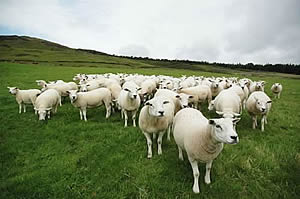07/09/07
Correct diagnosis, appropriate chemical choice and timely treatment
of sheep scab this season will save English flock managers significant
amounts of time and money, avoid compromising flock health and
performance and reduce the risk of resistance development, advises
the English Beef and Lamb Executive (EBLEX).
Recent studies have confirmed a high level of scab awareness amongst
producers, together with considerable interest in co-operating
with neighbours to control the highly contagious mite infections
responsible for it.
However, they have also shown a relatively large proportion of
samples taken from flocks thought to have the disease actually
testing negative for scab. At the same time, around 9-10% of producers
have been found to be treating scab with inappropriate products.
Because sheep scab and lice both become more prevalent in the winter
and cause very similar irritation, itching, rubbing and wool loss,
the two health problems are difficult to tell apart. Scab tends
to be more severe and, unlike lice which are generally only found
on sheep with a Body Condition Score of less than 3.0, can be present
in sheep in any condition. Nevertheless, it is almost impossible
to accurately diagnose from visual symptoms alone.
Precise diagnosis hasn’t been so critical where dipping has
been the primary treatment, given the wide activity of OPs against
a range of external parasites. The move away from dipping due to
strict regulations and towards more specific injectable anthelmintic
treatments makes good diagnosis more important.
As well as being a waste of time and money if scab is not actually
present, using such anthelmintics inappropriately increases the
danger of resistance developing among both intestinal worms and
scab mites. It also risks leaving the real cause of the problem
and its associated health and performance consequences untreated.
Under these circumstances, EBLEX advises all flock managers to:
- Assess
scab status carefully ahead of tupping;
- Have the vet take samples
if scab is suspected and only treat once it is confirmed;
- Quarantine
any bought-in or returning stock for 3 weeks, observe them closely
and, if necessary, treat them to ensure scab is not brought into
the flock;
- Ensure farm boundaries prevent sheep coming into contact
with neighbouring flocks;
- Avoid using pour-ons, jetters or showers
to control or treat scab;
- Dose for the heaviest animal in the
group when using injectables; and,
- Co-operate with neighbours
to treat all flocks within a 2-3 week period.
Practical advice for controlling sheep scab and other external
parasites is available to all English levy payers in a special
Lamb Action for Profit fact sheet – Better Returns from Planned
External Parasite Control – available from EBLEX on 0870
2418829 or by e-mailing brp@eblex.org.uk. More detailed information
and guidance linked to the factsheet can be obtained through the
unique interactive website resource at www.eblex.org.uk.
 Lumbylaw Texel Flock Sells after 30 Years of Breeding Lumbylaw Texel Flock Sells after 30 Years of Breeding
 Early Maturing Hampshire Downs Maximise Returns Early Maturing Hampshire Downs Maximise Returns
 Lleyn Sheep Society Introduce New Registration Tag Lleyn Sheep Society Introduce New Registration Tag
|



